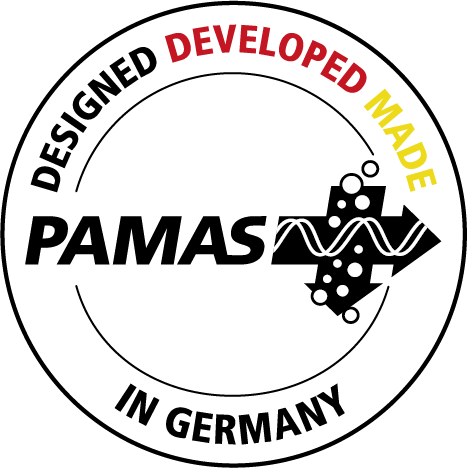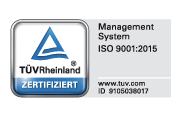FAQs
General information
Where can I learn more about particle counters and their practical applications?
You can find more information on various applications, standards, technologies, products, and events in our blog. For detailed inquiries, our experts are glad to assist you personally at info@pamas.de.
Can all liquids be measured with a particle counter?
Automatic laser particle counters are highly versatile and suitable for a wide range of liquids. For reliable measurements, the liquid must be transparent or at least translucent. Heavy turbidity caused by particulate contamination, a second liquid phase, or very dark fluids can interfere with the measurement by absorbing the laser beam or generating signal noise.
Are there liquids that cannot be measured or are difficult to be analyzed?
Yes, there are liquids that cannot be analyzed with an automatic particle counter or require special preparation:
- Two-phase liquids
- Emulsions
- Heavily contaminated liquids
Two-phase liquids and emulsions require a different measurement principle, such as microscopy (e.g., with the PAMAS FastPatch2GO), while heavily contaminated liquids can be analyzed with a laser particle counter after appropriate dilution (e.g., automatic dilution with the PAMAS S50DP).
More information here.
Can different types of liquids be measured with the same particle counter?
The range of application for an automatic particle counter depends on the design of the device. Portable and online particle counters are generally intended for similar, miscible fluids – for example, different types of oil or oil-compatible liquids such as diesel fuel.
For varying sample types, laboratory devices like the PAMAS SBSS are ideal. Thanks to their simple flow path design, they are easy to clean and can be used flexibly for a wide range of fluids, including oils and water-based media.
How can the distinction between particles of similar size be influenced?
The resolution between particles with slightly different sizes is primarily influenced by two parameters:
- Size of the measurement cell:
It affects the optical detection of the particles and thus the signal quality. A smaller measurement cell can, in principle, result in better optical resolution, as long as the set flow rate is reduced. - Selected calibration range:
It determines which particle diameters should be covered by the measurement range. A smaller calibration range increases the electronic resolution, provided the sensor is optimized for it.
A fine distinction between similarly sized particles is only relevant for specific applications, such as filter tests or grain size analysis.
What should I do if I have connection problems with the S40_Download2 software?
If you experience connection issues with your PAMAS particle counter while using the S40_Download2 software, please follow these steps:
- Check the user manual
Please refer to the relevant section of the individual user manual (e.g., S40 Series Appendix C “Download Software”) for basic information on setting up the connection. - Check for possible issues
- Is the USB driver correctly installed?
→ You can find instructions and installation guides here (75AP101 PAMAS driver installation). - Is the COM port correctly installed and activated?
→ Instructions and installation guides can be found here (75AP101 PAMAS driver installation, search term: Load VCP). - Is the S40 mode enabled on the device?
→ The PAMAS particle counter must be operated in the S40 mode to allow proper communication with the S40_Download2 software.
→ Check the mode setting as described in the corresponding user manual (e.g., S40 Series, Chapter 8.4 Advanced System Settings (Admin Setup), Section Simulation S31/P40).
Note:
If you encounter USB related issues, changing the cable or using a different USB port on the PC may help. If problems persist, please contact PAMAS Service.
How do I connect my PAMAS particle counter to a PC?
The connection depends on the specific model:
- PAMAS SVSS / SBSS (e.g., for measurements with PMA or USP software)
For these particle counters, a USB-to-serial adapter (RS232) and a serial cable or a serial cable with an integrated adapter are required (both included in delivery).
Connection steps:
- Connect the particle counter to your PC via the serial cable (9-pin D-Sub connector) and the USB adapter.
- Driver installation: Under Windows, the necessary driver is usually installed automatically. If not, you can download the driver from the manufacturer's website (Axagon® or Digitus®) or via the USB flash drive which was supplied with your particle counter.
- PAMAS S40 / S4031 (e.g., for measurements with PMA or for the S40_Download2 software)
For these particle counters, no extra adapter is required, as they have a built-in USB-to-serial adapter. Only a USB cable with a USB-B connector is needed to connect to the PC (included in delivery).
Connection steps:
- Connect the particle counter to your PC via the USB cable.
- Driver installation: The necessary drivers are located on the supplied USB flash drive or for download from the PAMAS website here. When installing the drivers via the Device Manager, note that the installation must be done in two stages. First, install the USB driver, and then install the serial (COM) driver. Step-by-step instructions can be found here (75AP101 PAMAS driver installation).
- PAMAS AS3 (for measurements with AutoSampler3 software)
For the PAMAS AS3, two USB-to-serial adapters (RS232 + RS485) with corresponding USB cables are usually required (both included in delivery). Alternatively, an Ethernet-to-serial adapter or a computer with an integrated PCI-to-serial adapter (PCI-Express card) can be used.
Connection steps:
- Connect the particle counter’s robot via the RS232 cable on the back to the RS232 converter.
- Connect the particle counter’s counting unit via the RS485 cable on the back to the RS485 converter.
- Connect both converters to the computer via USB cables.
- Driver installation: Under Windows, the necessary drivers are usually installed automatically. If needed, the necessary drivers are on the supplied USB flash drive or can be downloaded from the manufacturer's website here and can then be installed manually via the Device Manager.
- For the Ethernet-to-serial adapter or the PCI-to-serial adapter, no USB cables are required; just connect the cables on the back to the respective ports on the adapter. The corresponding drivers and required configuration software can be found on the manufacturer's website here, here and here.
- PAMAS FastPatch 2 GO (for measurements with PxF FastPatch software)
For this particle counter, two USB cables (3.0 + 2.0) are required (both included in delivery and permanently mounted). The supplied laptop has all necessary drivers and programs pre-installed.
Connection steps:
- Connect the particle counter's camera via the USB 3.0 cable to a USB 3.0 port on the laptop.
- Connect the particle counter’s X-Y table via the other USB cable to the laptop and power the adapter externally (power supply included in delivery).
- If necessary, install the "IDS peak" program for the camera and "SwitchBoard" program for the X-Y table. These programs are on the supplied USB flash drive.
- If needed, manually install the drivers for the camera and X-Y table via the Device Manager. The drivers are on the supplied USB flash drive.
- PAMAS 4132 (for measurements with Beta Test software)
For this particle counter, an Ethernet cable is required (not included in delivery).
Connection steps:
- Connect the particle counter to the local network via the Ethernet interface.
- Start the Beta Test software and enter the pre-configured IP address of your particle counter into the appropriate fields (Upstream/Downstream).
- If necessary, change the network configuration of your particle counter using the Pamas.Configurator software (see description below at PAMAS 4132).
- PAMAS S50(P/DP) / OLS50P / OLS4031 (for measurements with POV or PCT software)
For these particle counters, a USB-to-serial adapter (RS485) and a serial cable are required (both included in delivery).
Connection steps:
- Connect the particle counter to the RS485 adapter via the serial cable (9-pin D-Sub connector).
- Connect the RS485 adapter to the PC via USB.
- Driver installation: The driver installation should occur automatically under Windows. If needed, the necessary drivers are on the supplied USB flash drive or can be downloaded from the manufacturer's website here and can then be installed manually via the Device Manager.
- PAMAS 4132 / S50(P/DP) / OLS4031 / OLS50P (for changing the counter configuration with the PAMAS.Configurator Software)
Typically, the counter configuration does not need to be changed, as the particle counters are delivered pre-configured.
IMPORTANT: If your requirements change over time and reconfiguration is necessary, USB-A to Mini-USB cables and the PAMAS.Configurator software are required (not included in delivery).
Connection steps:
- Connect the particle counter to the PC via the USB cable.
- Driver installation: The necessary drivers are sent out after request. When installing the drivers via the Device Manager, note that the installation must be done in two stages. First, install the USB driver, and then install the serial (COM) driver. Step-by-step instructions can be found here (75AP101 PAMAS driver installation).
Calibration
Why is it important to adhere to the stipulated calibration intervals?
Regular calibration is the only guarantee for reliable measurements, as well as the comparability of results over multiple years and with other users. Unlike a broken ruler, you cannot visually tell if a particle counter is still delivering reliable results just by looking at it.
Does the validity of a calibration depend on how often the particle counter is used?
No, the validity of a calibration does not depend on how frequently the particle counter is used. According to common calibration standards such as ISO 11171 and ISO 21501-3, recalibration is required at intervals of no more than 12 months – regardless of whether the device is used daily, occasionally, or not at all.
What is the process for annual calibration?
Depending on customer preferences and the model, the following options are available:
- A trained service technician comes on-site for calibration (typically for laboratory particle counters like PAMAS SVSS / SBSS / AS3).
- The particle counter is sent to the responsible PAMAS service center (typically for portable or online models like PAMAS S40 / S4031 / 4132).
Usually, the responsible PAMAS service center coordinates communication regarding appointment scheduling. If you have any questions about calibration, feel free to contact us at info@pamas.de.
How do I ship my PAMAS particle counter?
The "Shipping instructions" with document number 75AP110 can be found on your PAMAS USB flash drive or here.
Measurement
How much sample volume is required for a measurement?
The required sample volume depends on the particle counter model and the specific application. Portable particle counters typically require several 100 ml, while laboratory instruments often operate with approximately 50 ml or less. With suitable accessories, measurements with just a few hundred microliters are possible using the PAMAS SVSS.
Many PAMAS devices offer the flexibility to adjust the sample volume to your needs within the device’s technical limits. One exception is pharmaceutical applications according to pharmacopoeia methods, where sample volumes are usually strictly defined.
What containers are best suited for sampling?
In principle, many different types of containers can be used for sampling – as long as they are clean and have been properly sealed. For some particle counter models, a maximum container size must also be considered. To ensure reliable measurement results, the container should be sealed immediately after sampling to prevent potential contamination.
Why do I need to prepare my sample before measurement?
Sample preparation has a significant impact on the measurement results. Without proper or correct preparation, the results will not reflect the actual particle content.
More information here.
What impact do particles outside the calibration range have on my measurement result?
Particles outside the calibration range affect the measurement result differently depending on their size. To illustrate this, here is an example with a standard 50/50 sensor and a calibration range of 2–50 µm.
- Larger particles:
Particles that are larger than the calibration range will still be detected because the measurement channels count all particles that are larger than the respective channel threshold. This means that even a 200 µm particle will be counted and appears in all measurement channels. Only when a differentiated statement about the actual size of larger particles (e.g., 190 µm vs. 200 µm) is required, the calibration range and possibly the sensor need to be adjusted accordingly. - Smaller particles:
Particles smaller than the calibration range typically have no direct impact on the measurement result. However, if their concentration is very high, it can affect the noise behavior and even negatively influence the lowest measurement channel due to increased counts.
What influence does a high particle concentration have on the measurement result?
The higher the concentration of particles, the more likely it is that two or more particles are in the measurement cell at the same time and are counted as one particle. This is known as "coincidence". As the concentration increases, this coincidence error also increases.
More information here.
How does my sample liquid flow through my PAMAS particle counter?
Depending on the model, the following options are available:
- A syringe module ensures precise control over volume and flow rate.
- A pump can provide continuous flow for measurements or online applications involving high sample volumes.
- By integrating the sensor with a flow controller into existing circuits, customized applications can be implemented.
What is the purpose of the head-pressure required for some particle counters?
The head-pressure ensures that no vacuum or negative pressure is created in the lines, preventing air bubbles from forming, depending on the viscosity and flow rate of the liquid.
- PAMAS SBSS with syringe module: The head-pressure ensures that the sample is pushed through the sensor rather than being sucked in.
- PAMAS particle counters with a pump: The head-pressure ensures optimal flow of the sample to the pump.
How does moisture in an oil sample affect the measurement result?
The effect depends on the water content:
- Undissolved (free) water droplets form two separate phases in an oil sample, making it impossible to be correctly analysed by optical particle counters, as this would distort the measurement result (see also here).
Such samples can be correctly measured using a microscope, like the PAMAS FastPatch 2 GO. - Slightly cloudy oil samples can be clarified by dilution with a moisture-masking liquid (e.g., Aerosol OT), allowing them to be measured correctly.




